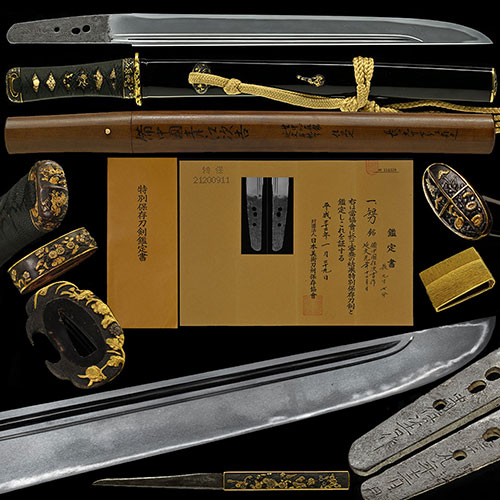
次吉 短刀 Tsuguyoshi Tanto
No.391011短刀 備中国住次吉作 延文元年十二月日 時代拵付 重要候補 乱れ映り立ち飛び焼き掛り匂口明るく冴える名品 九寸七分Bicchu nokuni jyu Tsuguyoshi saku, December, Enbun 1, With Jidai Koshirae, Juyo Candidate, Midare-Utsuritachi, Tobiyaki-kakari, Nioikuchi is bright and clear. A masterpiece 29.4cm
ご成約Sold
- 銘表Mei-Omote
- 備中国住次吉作Bicchu nokuni jyu Tsuguyoshi saku
- 裏銘Ura-mei
- 延文元年十二月日December , Enbun 1
- 登録証Registration
- 神奈川県 Kanagawa 昭和26年3月19日 3/19/26(Showa)
- 時代Period
- 南北朝時代延文元年Nanbokucho period, first year of Enbun
- 法量Size
-
刃長 29.4cm 反り なし 元幅 2.7cm 元重 0.38cm 茎長 10.2cm 重量 138
Hachou 29.4cm Sori なし Moto-Haba 2.7cm Moto-Kasane 0.38cm Nakago-Chou 10.2cm Weight 138
- 国Country
- 備中Bicchu
- 姿Shape
- 平造、三ツ棟、身幅やや広く、反りなし。Hiradukuri, Mitsumune, Slightly wide Mihaba, No Sori.
- 鍛Kitae
- 小板目肌つみ、杢目肌交じり、地沸微塵につき、乱れ映りたつ。Small-Itamehada-tsumi, Mixed Mokumehada, Jinie entered finely, Midare-Utsuritatsu.
- 刃文Hamon
- 直刃調に、浅くのたれて、ほつれ・湯走り・飛び焼き・うちのけ風掛り、小足・葉入り、小沸よくつき、細かく金筋掛り、匂口明るい。Suguha-style, Shallow Notarete, Hotsure, Yubashiri, Tobiyaki, Uchinoke-style-kakari, Small-Ashi and You entered, Small-Nie entered well, Finely Kinsuji-kakari, Nioikuchi is bright.
- 帽子Boushi
- 浅く乱れ込んで先尖りごころに深く返る。Shallow Midarekonde, Saki-Togarigokoro Deep return(Fukaku-kaeru).
- 茎Nakago
- 生ぶ、先栗尻、鑢目大筋違、目釘孔三。Ubu, Sakikurijiri, Yasurime-Ohsujikai, Mekugiana are three(3).
- ハバキHabaki
- 金着二重。Kinkise Double(Double layered with gold.)
- 拵Sword mounitings
- 黒蝋色塗鞘短刀拵 [江戸時代]
法量
長さ47.0cm 反り0.6cm
説明鐔 赤銅魚子地秋草図金色絵、 縁頭 赤銅魚子地秋草図金色絵。 目貫 赤銅虫と秋草図金色絵。栗形・反り角・鐺 赤銅石目地秋草図金色絵。切羽 銀金着。Kuro-rou Iro-nurisaya Tanto Koshirae(Black wax-colored lacquered scabbard) Edo period
Length: 47cm
Sori: 0.6cm
Tsuba: Syakudou Nanakoji Akikusazu(autumn grass design) Kiniroe
Fuchigashira: Syakudounanakoji Akikusazu(autumn grass design) Kiniroe
Menuki: Syakudou Mushi (Insects) and Akikusazu(autumn grass design) Kiniroe
Kurigata: Sorituno
Kojiri: Syakudou Ishimeji Akikusazu(autumn grass design) Kiniroe
Seppa: Gin and Kinkise (Silver and gold-plated.) - 彫物Carving
- 表裏に棒樋と添樋を掻き流す。Bohi and Soebi from front to back.
- 説明Drscription
- 備中青江派は、備中高梁川下流域を中心に活躍した刀工群で、平安末期承安頃の安次を祖として始まると伝えられ、平安末期から鎌倉前期暦仁頃までのものを古青江、それ以降を青江と大別している。次吉は、次直・守次らと並び、南北朝期の青江を代表する名工である。この刀は、延文元年の年紀が入る次吉の在銘作で、身幅やや広く、僅かに内反りつく端正な姿を呈し、地沸微塵に付き、乱れ映りがたつ精良な地鉄に、直刃調に、浅くのたれて、湯走り・飛び焼き頻りに掛り、足・葉よく入り、匂口締まり明るく冴える名品である。Tsuguyoshi, along with Tsugunao and Moritsugu, is a master swordsmith representing Aoe during the Nanbokucho period.
The Bitchu Aoe school is a group of swordsmiths who were active mainly in the lower reaches of the Takahashi River in Bitchu. Said to have begun by Yasutsugu around the Joan period in the late Heian period, Aoe is roughly divided into those from the late Heian period to the early Kamakura period around Ryakunin, and those from after that are called Ko-Aoe, and those from that period onwards are called Aoe.
This sword is a signature work of Tsuguyoshi, dated the first year of Enbun. It has slightly wide Mihaba, Slightly Uchizoritsuku that presenting a neat appearance, Jinie entered finely, Midare-Utsuritatsu with clear Jigane, Suguha-style, Shallow-Notarete, Yubashiri, Tobiyaki-shikriinikakari, There are many Ashi and You, Nioikuchi-shimari A bright and clear A masterpiece.



